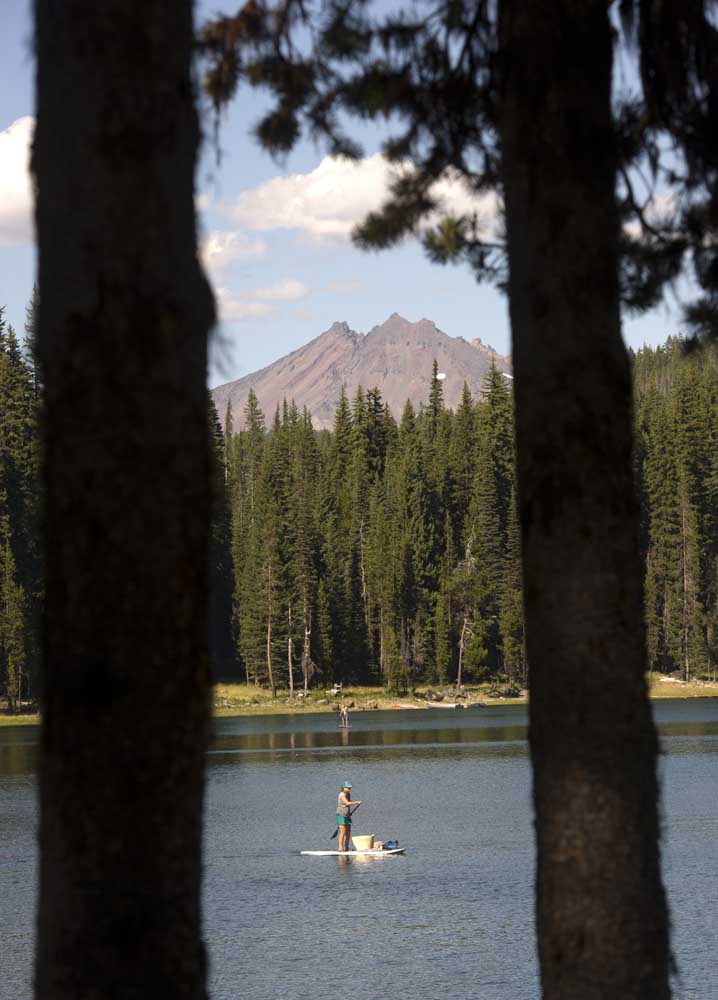Standing up to the wind
Published 12:00 am Wednesday, August 13, 2014

- A stand-up paddleboarder paddles her way around Elk Lake last summer. (Ryan Brennecke / The Bulletin)
Realizing I had no watch, I quickly ran back to my car to retrieve my phone so I could keep track of the time to ensure a prompt return of my rented paddleboard.
As I moved from my knees to a standing position atop the board near the boat ramp, then bobbled a bit and almost fell into Elk Lake, I realized the stupidity of that last-second decision to grab my phone.
The prospect of being forced to buy a new cellphone was sufficient motivation for not losing my balance and splashing into the water. The phone was secure in the side pocket of my board shorts, but it took me 20 to 30 minutes to feel stable enough on the paddleboard to realize I could last two hours without tumbling into the chilly drink.
At one point during those first few minutes on the board, I made the decision to return to the boat ramp and leave my phone with the rental guy. But after I had paddled hard to turn back toward the resort, the wind was directly in my face and I was at a standstill. I decided to save my energy for when the two hours were up and I would have no choice but to paddle back into the wind.
Paddleboarding is something I entertain every few years, preferring to rent rather than shell out the $1,000 to $2,000 for a board and paddle. Elk Lake Resort, about 35 miles southwest of Bend off Cascade Lakes Highway, rents paddleboards for $20 per hour.
The last time I was on a paddleboard at Elk Lake, a few years ago, it was a calm morning with little wind. I made it all the way from the rental area near the north end of the lake to the south end and back for a total distance of about 5 miles. I realized quickly last week that a repeat of that smooth ride was not going to happen.
“When the wind is blowing here and you’re going against it, you definitely feel it,” another paddleboarder told me. “That can add some challenge.”
Can it ever.
Sometimes lakes can be more appealing than rivers to novice stand-up paddleboarders, as lakes have no currents to deal with. But when the afternoon wind is blowing on a Cascade lake, paddling on still water might be just as difficult.
Elk Lake is probably the most popular lake in Central Oregon for stand-up paddleboarding, but paddleboarders can also be found on Sparks, Hosmer, Lava, Cultus, Davis and Odell lakes, as well as on Crane Prairie and Wickiup reservoirs.
Once I felt secure enough on the 10-foot-long board to stop worrying about my phone, I enjoyed the views of South Sister, Broken Top and Mount Bachelor, all visible from the northwest part of Elk Lake.
The strong wind continued to push me toward the north end of the lake, and after paddling against the wind for a while, I finally let it take me to a spot on the north shore for a much-needed break.
After a few minutes, I got back on the board and paddled northward up against the west shore, hoping to be sheltered somewhat from the wind. I noticed the clear water and the light, sandy bottom of the lake as I paddled near the shore. I continued to paddle around the middle part of the lake for the remainder of the two hours, surviving some choppy conditions and hordes of other paddlers.
According to Bend’s Randall Barna, an advisory board member for the World Paddle Association, flatwater paddleboarding is performed basically in two styles: adventure, for which a paddleboarder sets a goal, and racing, for the element of competition.
Stand-up paddleboarding is commonly noted for the core (abdominal) workout it provides.
“Every muscle in the body gets used,” Barna said. “The human body was made to exercise standing up, not sitting down.”
Indeed, when I awoke the next morning, my abdominals, upper back and legs were all sore.
If stand-up paddleboarders get tired or have trouble balancing in rough water, they can simply sit on the board or paddle on their knees.
I remained upright for the entire ride last week, but even higher winds on bigger lakes can be more challenging. Some stand-up paddleboarders seek out “down-winders,” during which they ride over waves on big lakes with high winds at their backs.
Most rivers get little wind action, but paddleboarders can still find some challenging long-distance tours on the Deschutes, such as the 35-mile stretch southwest of Bend from Pringle Falls to Benham Falls.
I think my next paddleboard outing will be on the Deschutes, and with luck, the wind will be light.
I’ll leave my phone in the car.
— Reporter: 541-383-0318,
mmorical@bendbulletin.com






